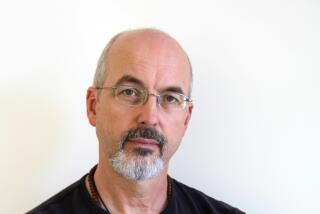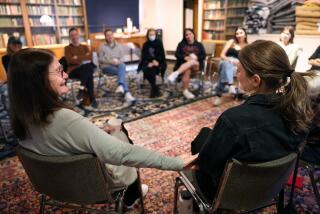What happens to a personâs Facebook posts after they die? One artist is using them to build digital memorials
On Sunday, I attended my funeral. It was a short ceremony, held in a small auditorium at the Los Angeles County Museum of Art. The pastor who led it made note of my professional accomplishments. He also cited my habit of eating straight out of the bulk bins at Sprouts. The ceremony ended with a video that featured a somewhat uncanny 3-D rendering of me walking into a peaceable, cloud-filled afterlife.
My âfuneralâ wasnât a real service. (The reports of my death are greatly exaggerated.) Instead, it was part of a yearlong multimedia project by New York-based artist Gabriel Barcia-Colombo. Titled the âHereafter Institute,â the project examines the ways in which we memorialize our dead in the digital age and what happens to our data when we die.
For the record:
11:50 a.m. Sept. 2, 2016An earlier version of this article gave the name of an actor playing a pastor as Andy Harris. His name is Andy Phillips.
The artist says he was inspired by the ways death is handled online.
âI keep seeing when people pass away on social media, of people commenting, but there is no formal ritual about it,â explains Barcia-Colombo. âAnd there are strange things about it â like peopleâs birthdays being marked for celebration even after they die.â
The âHereafter Instituteâ was supported by a grant from LACMAâs Art + Technology Lab and was on view at the museum for two days last weekend.
The show consisted, in part, of a series of physical objects used to commemorate death in futuristic ways. A digital locket, inspired by Victorian keepsakes, displayed video of a loved one on a loop. While a set of virtual reality goggles allowed the user to step into a rendering of a garden, where the artistâs deceased grandfather plucked away at a typewriter and recited poetry.
One of the more unusual pieces consisted of a sleek, black tower rigged with a record player that displayed all of an individualâs Facebook status updates on a screen. Clusters of words translated into sonic elements that served as an improvised score.
The idea, says Barcia-Colombo, was to render the intangibles of the Internet into something real. âItâs making it physical,â he says. âLiterally, a physical record.â
Itâs a record that is a bit disconcerting â since so much of what resides on Facebook is so banal. (When I die will I be remembered for Juan Gabriel memes, unicorn GIFs and photos of my dog?)
I keep seeing when people pass away on social media, of people commenting, but there is no formal ritual about it.
— Gabriel Barcia-Colombo
Joel Ferree of the Art + Technology Lab says he had been intrigued by Barcia-Colomboâs proposal because of the timeliness of the topic it covered: âHe was posing a very interesting question that we are only beginning to answer: How is technology reshaping our relationship to death?â
The artist answered this question via his sculptures â as well as an elaborate performance, staged with the aid of theater director Benita De Wit, that was as humorous as it was funereal.
To see Barcia-Colomboâs Facebook record player and other sculptures, visitors had to book a âconsultation appointmentâ with the fictional Hereafter Institute in order âvisualize their digital afterlife.â
The consultation consisted of an invented sales pitch for the artistâs various digital monuments. And the process included handing over my Facebook username, agreeing to a 3-D scan of my body and signing various forms. (The contemplation of death cannot go un-bureaucratized.)
I was then led on a sales tour by a lab-coated Hereafter consultant (in my case, theater and film actress Jessica Perlman), who struck just the right funeral home tone when discussing my âoptions.â
Adjunct curator Amy Heibel, founder of LACMAâs Art + Technology Lab, says this issue of commodification in Barcia-Colomboâs work was something that had appealed to her. (Two years ago, the artist created a vending machine that dispensed human DNA as a way of exploring issues of privacy and ownership in biotechnology.)
âWe were drawn to the aspect of his work that mimics commercialization because marketing, advertising, and so-called messaging are such a significant part of how advances in science and technology are understood, discussed and disseminated,â she said via email.
At the end of my âconsultation,â my Hereafter rep deposited me in a small theater on the ground level of the Bing Center, where I expected to watch some faux marketing film.
That is when my funeral began.
A pastor (played by Andy Phillips) strode onstage and welcomed everyone to my memorial service and proceeded to recite my biography â down to my inappropriate supermarket eating habits. The 3-D body scan Iâd had at the start of the piece was used to create the animated rendering that showed me walking off into a dreamy horizon.
I was both rattled and tantalized by the whole experience.
There was the thrill of being a voyeur at the one major life event you canât be around to experience. But there was also the fact that a man Iâd never met was talking about me as if he knew me, all based on information heâd gleaned from social media.
âThere are reams of data that you create,â says Barcia-Colombo. âIâm thinking of solutions to store this data in different ways.â
It turns out that when we die in the 21st century, our mundane experiences donât die with us. They live on in the algorithm.
For more on Barcia-Colomboâs âHereafter Institute,â log on to hereafterinstitute.com.
SIGN UP for our weekly Essential Arts & Culture newsletter Âť
Find me on Twitter @cmonstah.
ALSO:
Kanye Westâs famous âFamousâ sculpture is not for sale, gallery says
More to Read
The biggest entertainment stories
Get our big stories about Hollywood, film, television, music, arts, culture and more right in your inbox as soon as they publish.
You may occasionally receive promotional content from the Los Angeles Times.











